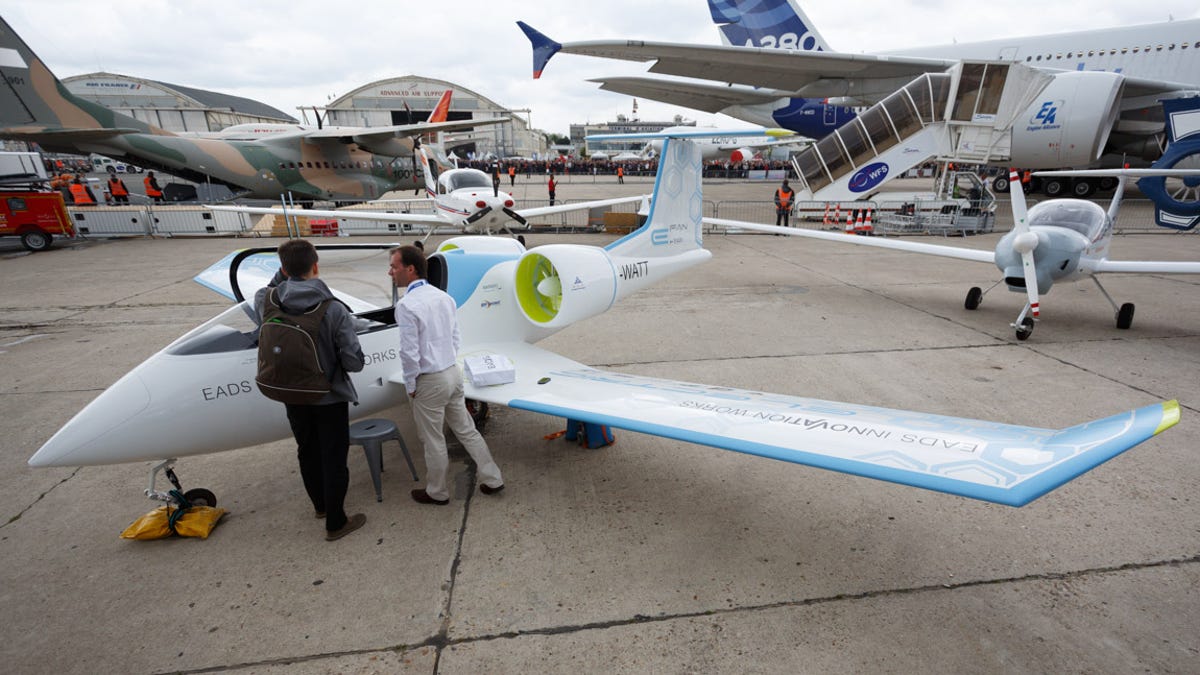Electric aircraft start finding a foothold in aviation industry
Don't expect an all-electric plane to carry hundreds of passengers soon, but in some corners of aviation, battery-powered aircraft are attracting industry interest.

LE BOURGET, France -- Maybe we should call them e-craft.
At the Paris Air Show here, a handful of companies tried out their own version of a change sweeping the automotive industry: electric power. There are abundant challenges to the approach, but some believe that the technology will catch on at least in some circumstances.
Early electric cars were small and light, and electric aircraft are following suit for the same reason: having less mass to push around means a vehicle can get farther on a limited amount of energy. Thus, you shouldn't expect a 250-passenger electric jet any time soon, but perhaps in a decade an all-electric six-seater Elektra E6 will carry you and a couple friends on a shorter flight.
The benefits of electric flight include lower carbon dioxide emissions, quieter aircraft, and machinery with less punishing vibration. Greenhouse gas emission is still an issue for coal and natural-gas power plants that supply the electricity, of course, but the supply of solar and wind energy is gradually increasing and even fossil-fuel burning plants can be more efficient than combustion in a small engine.
The old guard is working on improving efficiency with conventionally fueled aircraft, for example by moving to lighter materials such as carbon composites as in the case of the Boeing 787 Dreamliner. Its new rival, the Airbus A350 that's just made its first test flights, is 53 percent composite, 19 percent aluminum alloy, 14 percent titanium, 6 percent steel, and 8 percent other materials.
But several electric aircraft made news at the Paris Air Show, a top aeronautics event that attracts not just aviation buffs but also component suppliers and airlines looking to buy planes for their fleet. Among the aircraft:
• The E-Fan from aerospace giant EADS is a compact two-seater aircraft with lithium polymer batteries and dual electric propellers that produce 60 kilowatts of power. It can cruise at 100mph for 45 to 60 minutes for new pilots in training or 30 minutes as an acrobatic plane, EADS said. And one more novelty: when taxiing, it's driven by a powered wheel, not by its flight engines.
EADS expects "significant benefits" in the cost per hour to fly for initial training, and it's a lot quieter than conventional small planes. The E-Fan is subsidized in part by the French Directorate General for Civil Aviation (DGAC); the European Commission's Flightpath 2050 report calls for lowering carbon dioxide emissions by 75 percent and cutting noise by 65 percent from 2000 to 2050.
• EADCO, or European Aerospace Design Consultants, announced a partnership with PC-Aero to build the Elektro E6, a six-seat, two-engine electric aircraft that by 2019 will be able to carry a payload of 480kg up to 500km.
It's just a design for now, but the plan is to build a proof of concept in three years and a certified model in a decade. The wings' top surface will be layered with photovoltaic cells, though it's unclear how much of a boost to battery life that will give.
• AgustaWestland's Project Zero is more exotic, a single-passenger tiltrotor whose propellers produce upward thrust during takeoff then pivot to produce forward thrust for flight.
The company didn't disclose range, speed, or weight, but said the prototype on display at the air show does fly. It's also a prototype to develop and demonstrate what's possible, not an early version of an aircraft actually intended for production.
• The DA36 E-Star 2, an update to the Siemens' serial electric DA36 E-Star from two years ago. It's not, strictly speaking, an electric aircraft, but it is a step in that direction: it uses a battery-powered electric motor to drive the propeller but charges that battery with a small engine burning conventional fuel.
The DA36 E-Star 2 is built by Diamond Aircraft Industries; EADS Innovation Works, which supplies the batteries; and Siemens, which supplies the drive system based on a Austro Engine rotary engine. EADS is the aerospace giant that runs Airbus. Compared to the first-generation model that appeared two years ago at the same air show, the E-Star 2 increases engine power from 70 kilowatts to 80kW.
"The DA36 E-Star 2 demonstrates for the first time that a serial-hybrid electric aircraft is suitable for commercial use, providing an appropriate payload and range for a utility aircraft," the companies said.
Electric flight is unusual with passenger craft, but it's a closer fit for a much bigger trend in the aviation industry: unmanned aerial vehicles (UAVs), aka drones. Big drones used for launching missiles aren't electric, but small quadcopters and fixed-wing surveillance craft can be.
At the Paris Air Show, one such electric UAV on display was Tekever's AR1 Blue Ray designed for police who need surveillance.
"It can be used for crowd monitoring at major events with lots of people, or for VIP security for providing clearance ahead," said Pedro Petiz, a Tekever business-development manager. "You can carry it in a backpack. It snaps together," he said, adding that it's launched by hand but lands by parachute after a flight time of about 2 hours.
The big practical problem with electric aircraft is energy density -- the amount of energy that's stored in a given amount of material, energy that's extracted and converted into propellers spinning or some other form of propulsion. Batteries weigh a lot, and it's tough to match liquid fuel, which despite the energy-wasting inefficiencies of combustion still have a lot of oomph packed inside all those chemical bonds.
Tekever's larger drones, such as its AR5 that has an 8- to 9-meter wingspan, use conventional aircraft fuels because of the energy density requirements, Petiz said.

